2022 Guide to Backpacking Photography
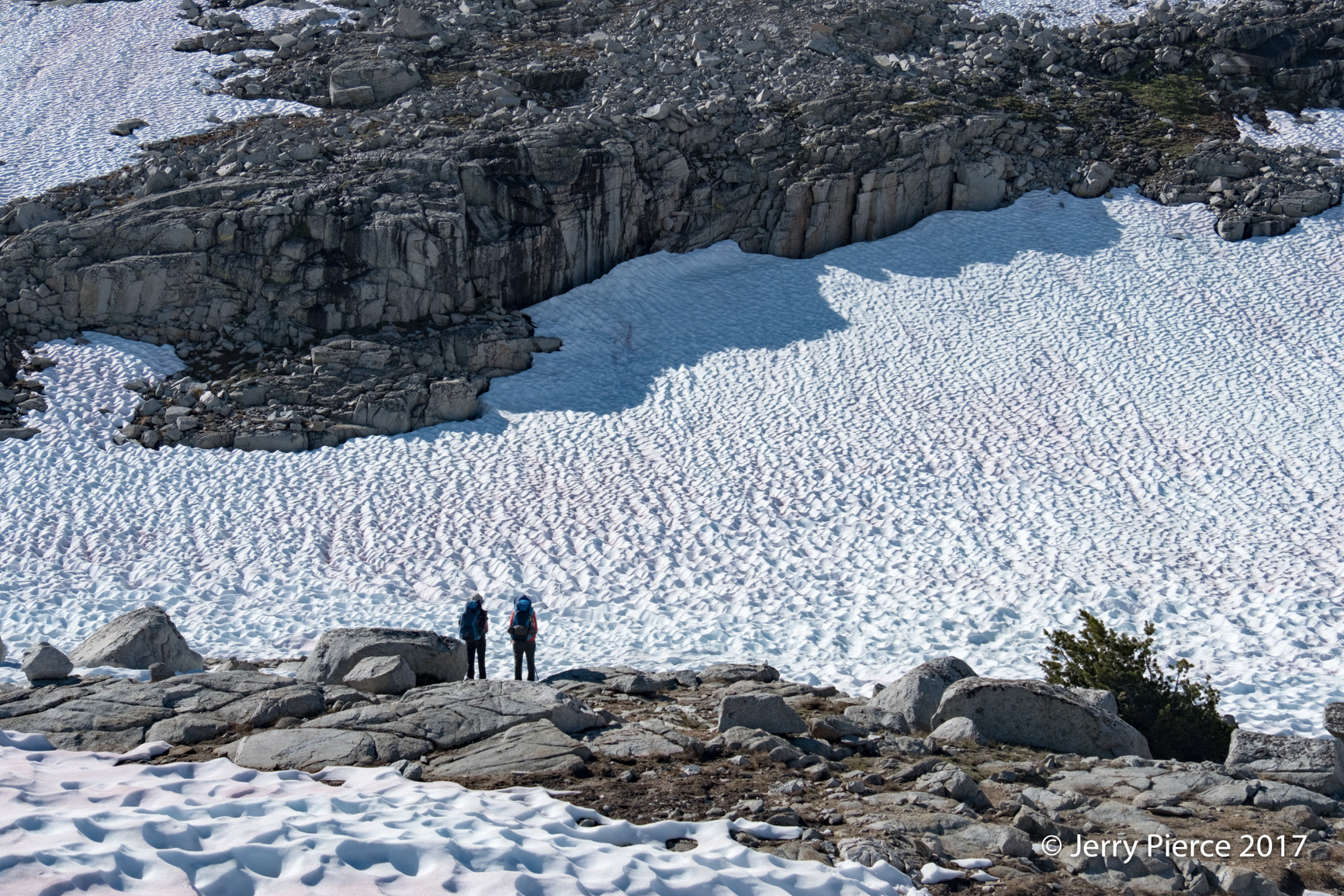
This is my 2022 version of my guide to backpack stuff. I have the current one (2023) and I’m working on the 2024 version, but it’s a work in progress and doesn’t have the updated weights and I’m still editing it. When I finalize the 2024 one I will update the main link.
What is Backpack Photography?
- You sleep on the ground
- It can be cold / hot / mosquitos / raining
- No shower for days
- Things may break. You may break.
- Ask me about my hernia…or not.
- Opportunistic photography
- If you can get the shot – great – otherwise hike on.
- No porter carries your stuff.
For me, Backpack photography is
“Opportunistic Photography.”
The hike comes first. This activity is not for everyone. Compared to my friends that also hike, I’m sort of middle of the pack. Others do less stupid things and they have really good hiking experiences.
Let me make one correction – it says “no porter carries your stuff” well that isn’t always the case.
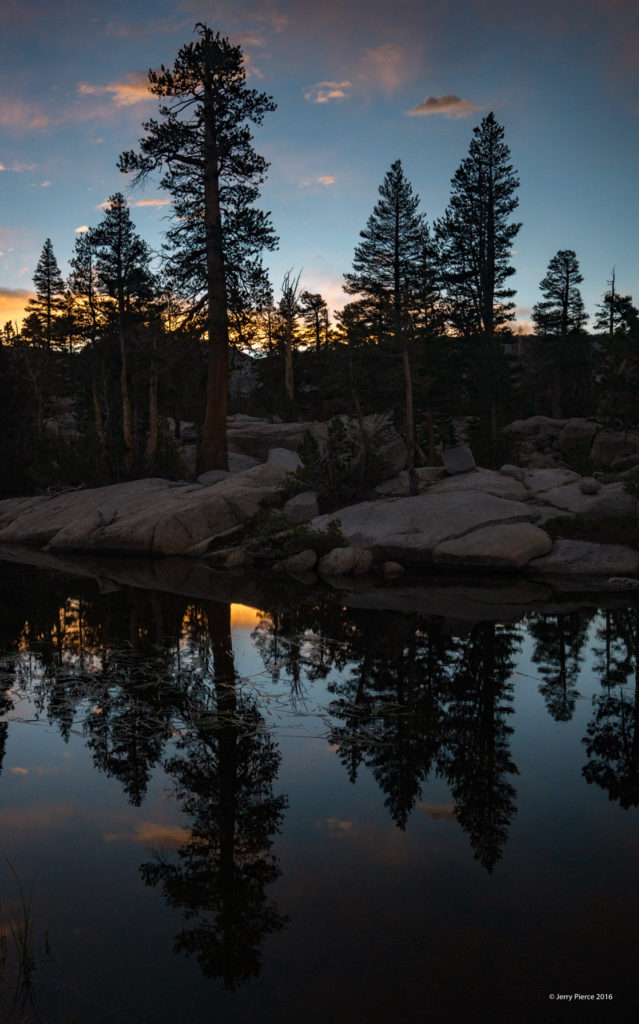
Outline
- What you bring
- PHOTOS!
- Taking, Storing & Sharing
So this is going to cover a batch of things about both hiking and photography.
Typical Hike
- 4-9 days on / off trail
- High Sierra
- Sleep most nights above 10K feet
- 5-8 hours per day hiking
- 2-4K feet elevation change/day
- 35-40 pounds on back at start
- 3-5 people
- more fun and safer
So what do **I** mean by a hike. It’s not a walk around the block. It’s some serious up and down. There was a hike we took last summer – off trail near Bishop in the high sierras. I’m going to use that as my example hike throughout this talk.
It ended up being 6 nights, 7 days hiking. 3 of us (Pat, Scott and me). We slept most nights above 11K feet. Total distance was 60 miles and we did 30,500 ft ascent in those 7 days
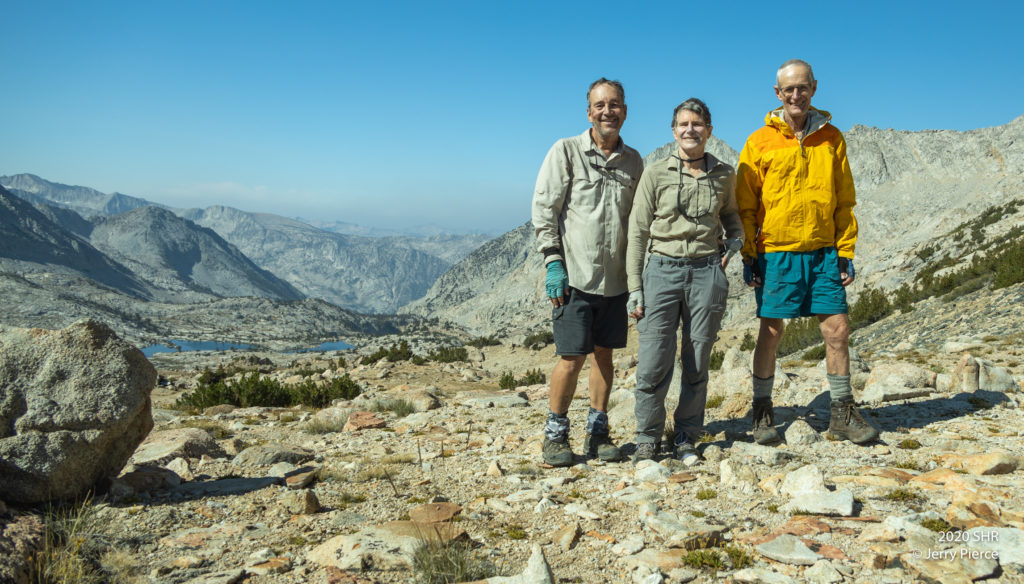

This is the altitude vs distance profile of that hike. A high of 13,200 feet. Lots of off-trail. If you look at the Talus Hell part of the hike, we did 7.5miles in 7 hours. That’s really slow. Lots of rock hopping.
One thing to note about these high sierra hikes is the huge temperature shift. It’s common to get up to over 90° while hiking and down to 25° in the morning. 70° variation over the day.
What You Bring - It’s all about the weight…
Every Ounce Counts …
- Overview
- Clothing
- Food, water, cooking, sleeping
- Electronics and camera
What you bring … You need creature comforts, but not at the expense of weight. I used to bring a Kindle, but found that it weighs too much for the benefits. If items can have multiple uses, that’s great. It really is that EVERY OUNCE COUNTS! I’ll do a lot to save a pound, except go on a diet before a hike…
Clothing (to wear) on-trail range of 35°F to 100°F (2°/38°C)
What’s on my body…
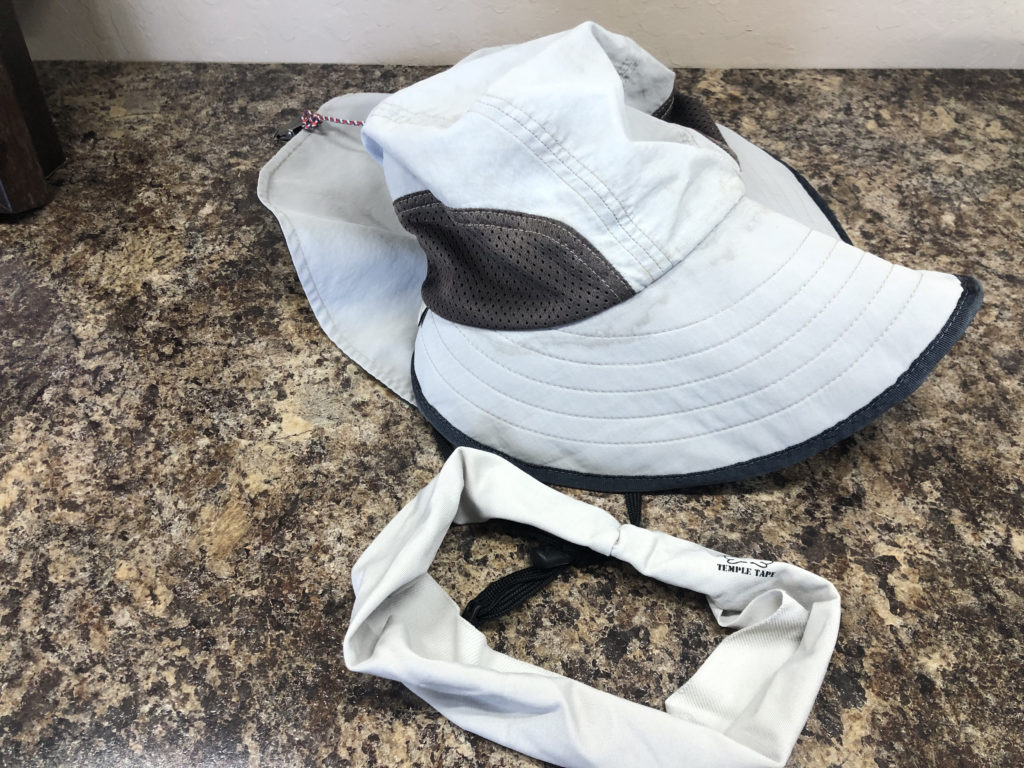

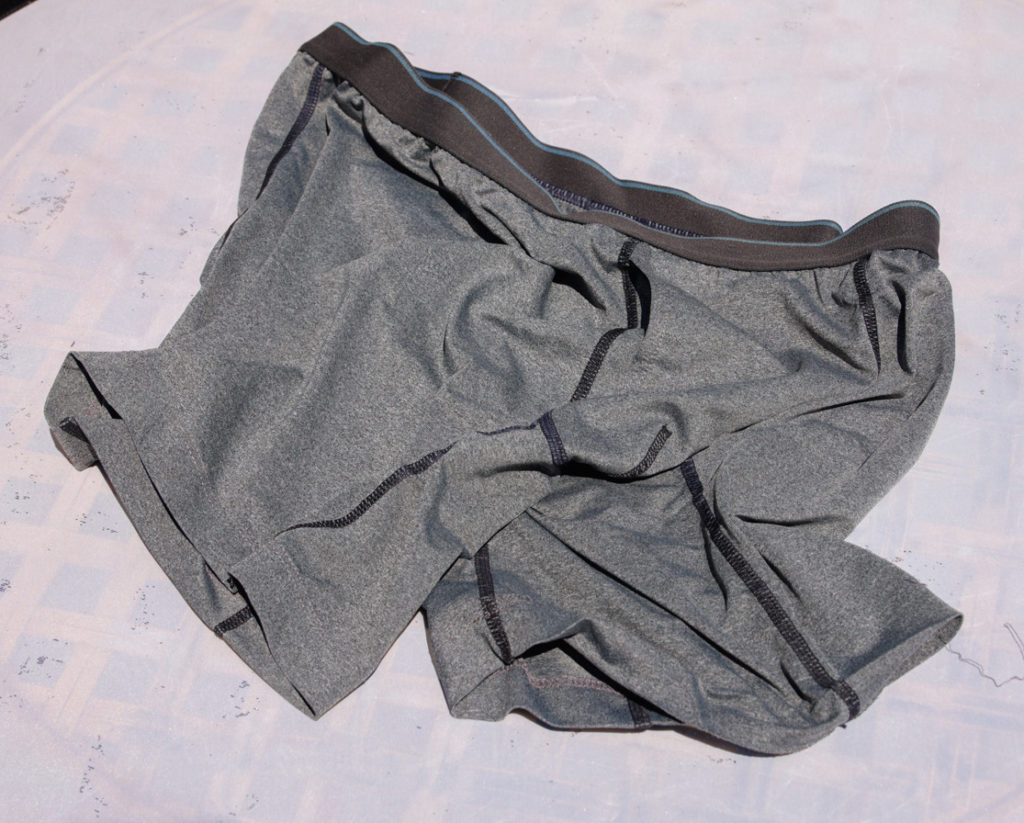
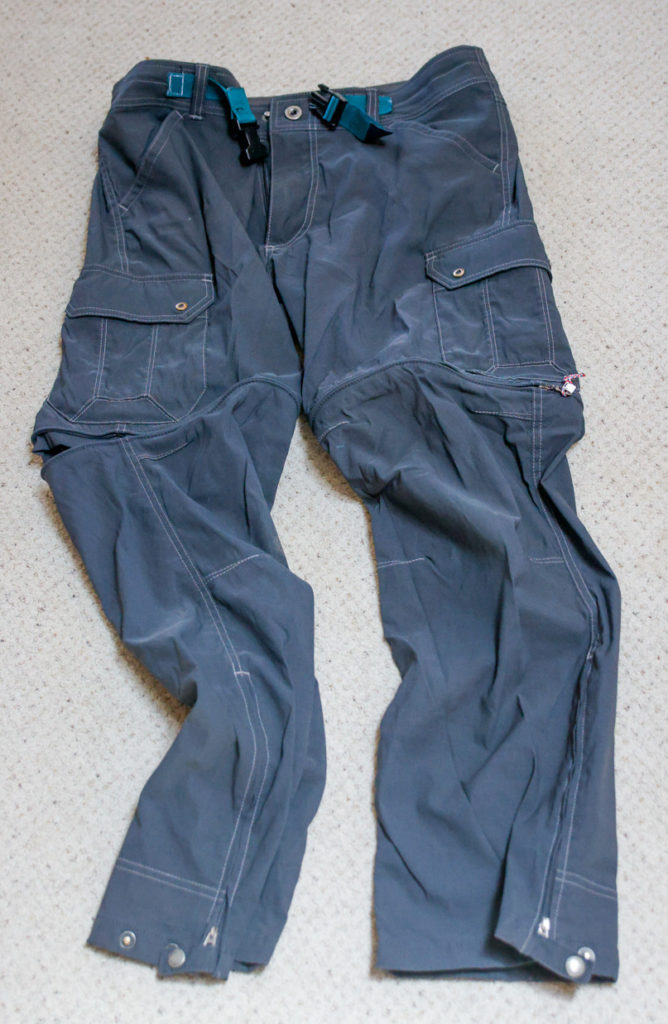


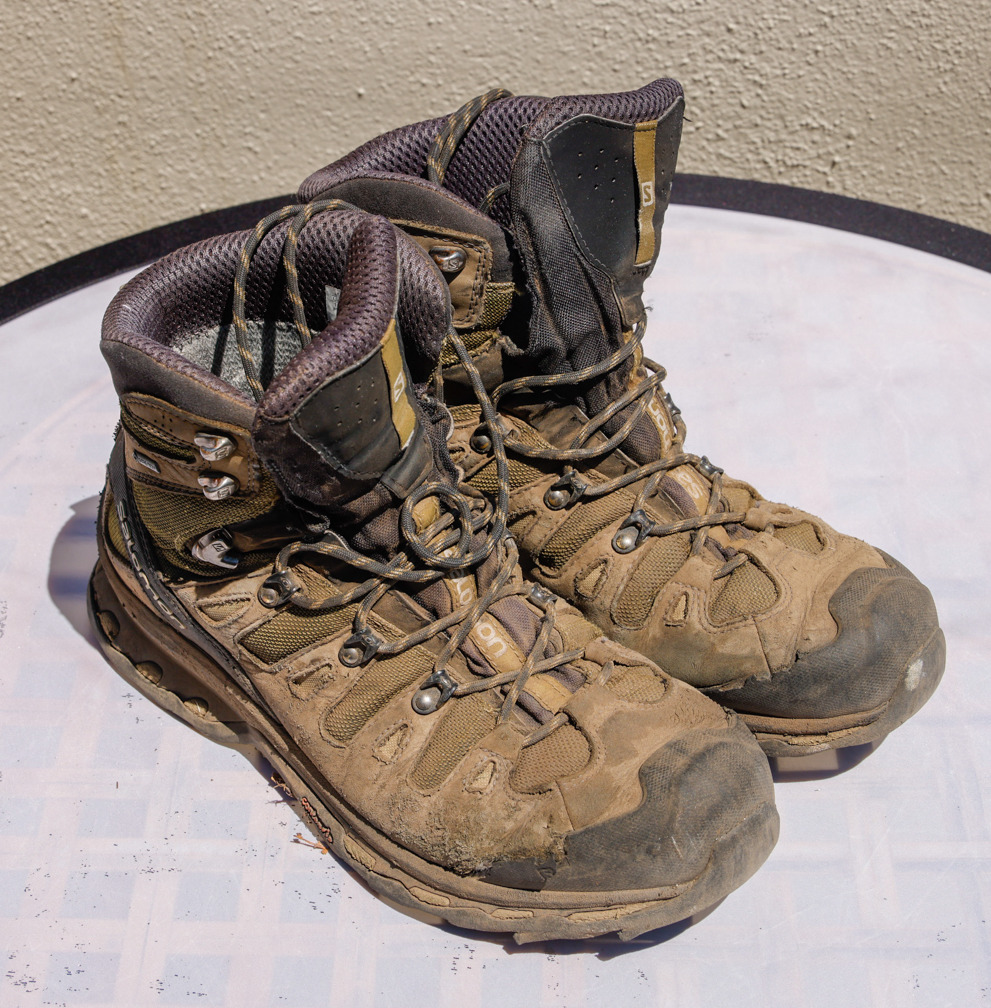


Grams | Pounds | |
Hat (and leash), headband | 79 | 0.17 |
|
|
|
“sun shirt” | 232 | 0.51 |
undies – very thin / easy to wash and dry. Also used as swimming pants (when not skinny-dipping) | 75 | 0.17 |
zip off pants – I like the thicker/sturdy pants by | 496 | 1.09 |
Hiking Gloves – Outdoor Research Sun Gloves work for me! I get them at Amazon. | 21 | 0.05 |
Dirty Girl Gators https://dirtygirlgaiters.com | 40 | 0.09 |
Socks -Darn Tough is the BEST https://darntough.com | 65 | 0.14 |
High top hiking shoes I found Salomon works for me. I get at REI for their fitting and return policy. | 1,500 | 3.31 |
Hiking Poles (with Duct Tape and Lucco tape) I found Costco has really good hiking poles and they are cheap! | 485 | 1.07 |
Progressive Glasses | 11 | 0.02 |
iPhoneX | 215 | 0.47 |
Watch – I use the Garmin Forerunner 935 watch, but I would get the later version (945) and the 955 is due out soon. I would buy at REI. I tried an Apple Watch, but it doesn’t work (for me) for hiking. I like the buttons, long battery life and the data screens. | 91 | 0.20 |
Total: | 3,270 | 7.22 |
Need to cover an EXTREME temp range (can add layers)
NO SHORTSLEEVE SHIRT
A shirt is cooler than skin
Protects from sun
Zip off pants
Shows off cute legs for on-trail style
Phone is for navigation
I carry 7.2 pounds on my body. This is separate from my backpack. This covers a huge range of temperatures – from just above freezing to 100 degrees.
I generally zip off the pant legs to make them into shorts. I try and cover as much of my skin as possible against sunburn and sweat is your friend in keeping you cool.
The heaviest weight is the high top waterproof hiking shoes. The PCTers (meaning Pacific Crest Trailer hikers) do about 25 miles a day and they wear running shoes to keep the weight down, but off trail you need the ankle protection and waterproof, hence the weight. This doesn’t include the 10 pounds of fat on my body. But that will be gone by end of summer.
Clothing – In Pack
25° to 100°F (-4°/38°C)
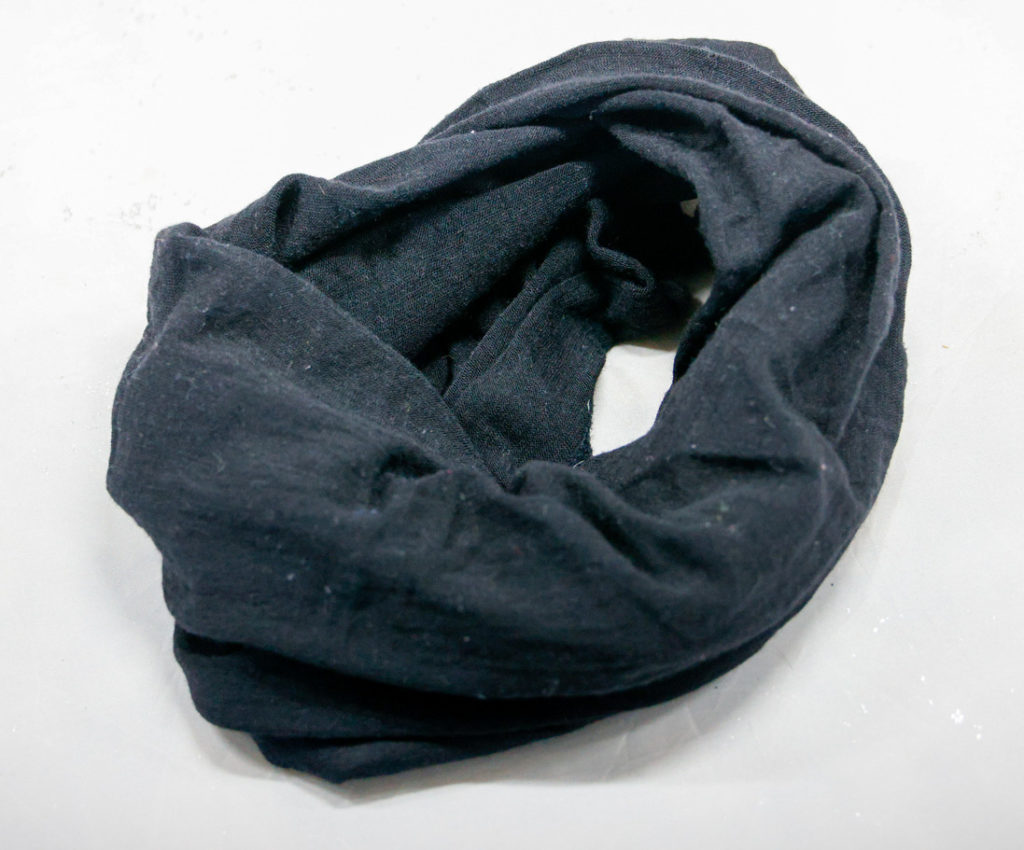
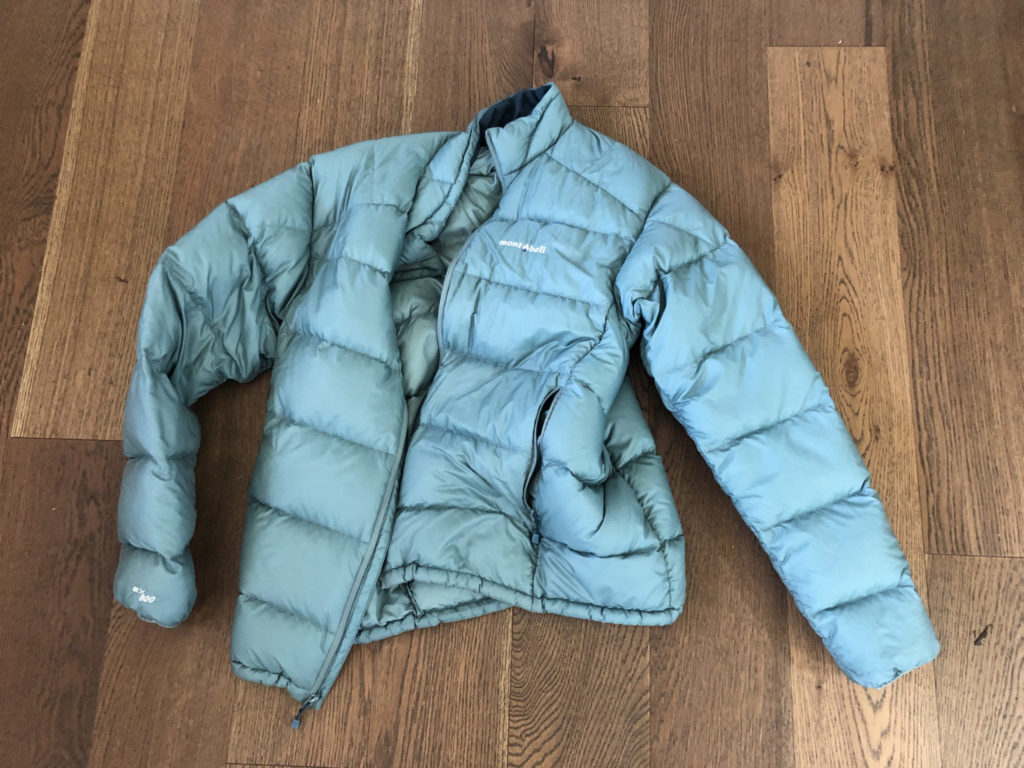
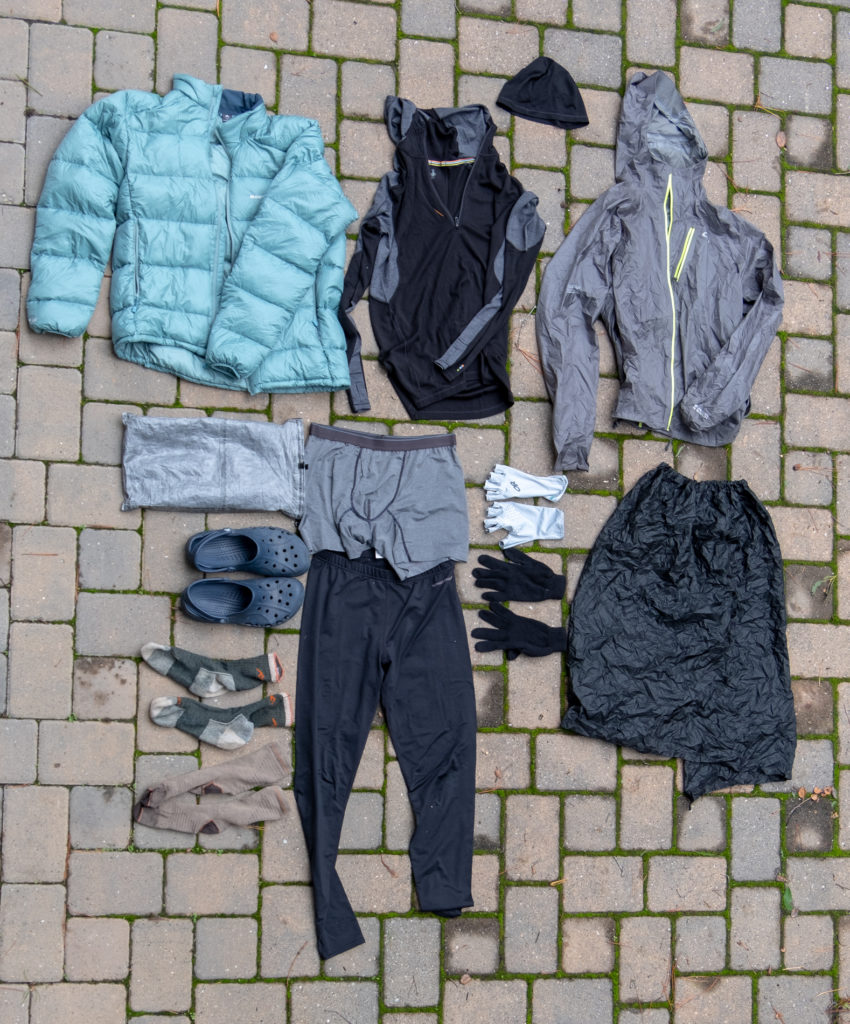
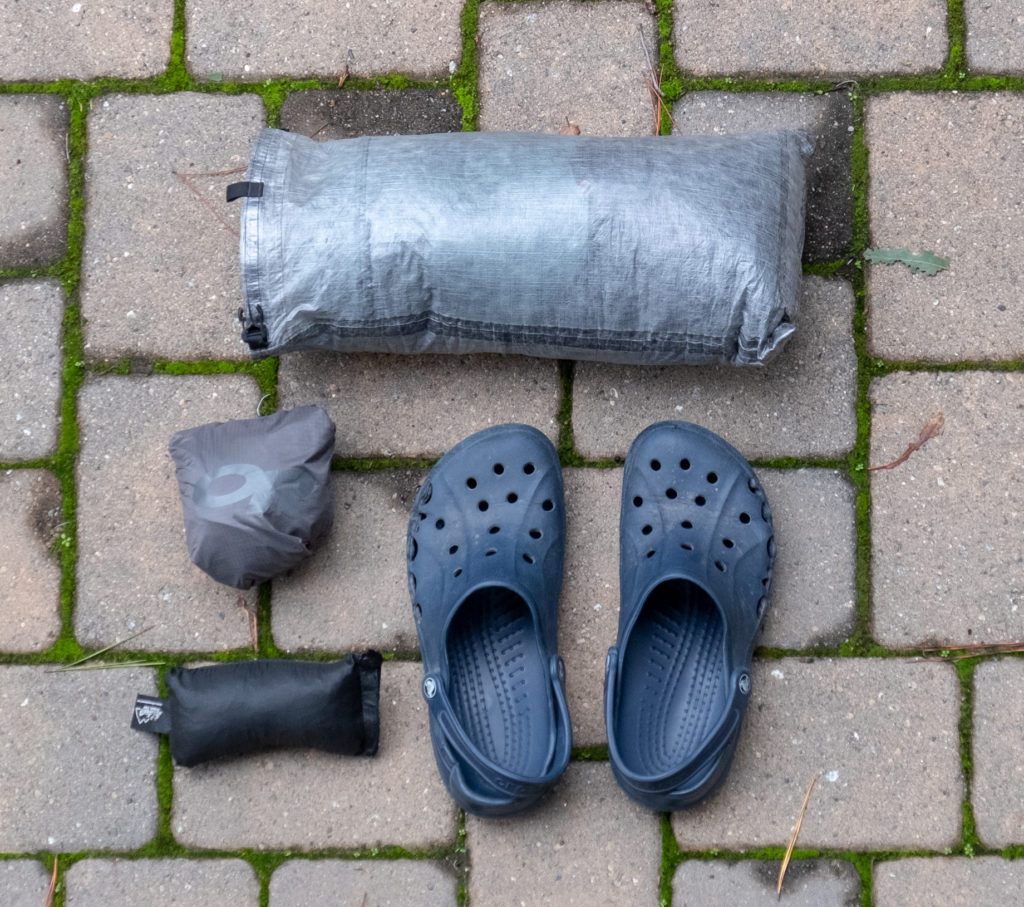
Grams | Pounds | |
Buff Merino Wool – REALLY good. I got it from REI. | 16 | 0.04 |
Base Hoodie (smartwool) BEST PRODUCT EVER! | 286 | 0.63 |
Down Jacket | 376 | 0.83 |
Waterproof Shell | 186 | 0.41 |
Gloves | 40 | 0.09 |
Undies (1) | 75 | 0.17 |
Long underware | 235 | 0.52 |
Hiking socks | 65 | 0.14 |
Camp socks | 43 | 0.09 |
Crocks (water shoes/in camp) | 351 | 0.77 |
Packing bags | 60 | 0.13 |
Down Cap | 81 | 0.18 |
Waterproof pants | 158 | 0.35 |
Glove Covers | 48 | 0.11 |
Total: | 2,020 | 4.46 |
Layers for rain
In-camp warmth
you are generally warm when hiking
8 days on trail.
I also have clothing in the backpack for in-camp, rain and sleeping. It’s a heavy load at 4 pounds of clothing! Everything is considered. I only bring two pair of undies for 8 days! They are thin and fast dry – so they get washed often. Socks are swapped at each lunch and one pair is washed daily. Everything to avoid getting blisters. Note no swim suit. It’s undies or nothing to swim. And once in a while you do find hot springs, otherwise it’s very cold alpine lakes. Most of the clothes are for in-camp warmth. The stuff sack does double duty as my sleeping pillow.
Hardware
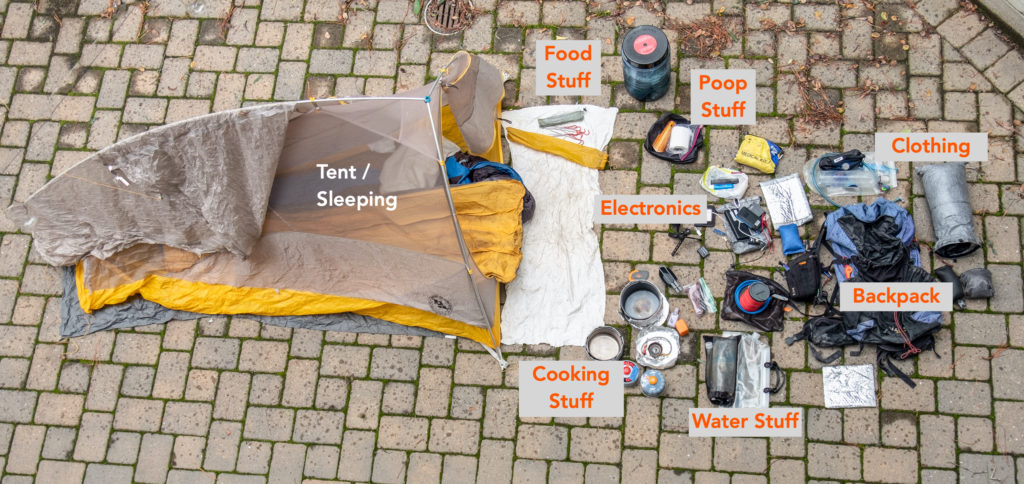
Now comes the hardware needed to be in camp and on the trail. All the stuff above fits into the backpack. Note at the top next to the “food stuff” is a bear canister that’s really big and needs to fit in the backpack as well…
The Pack
Strong / big enough to hold 40 pounds
Comfortable to carry for 20 miles
Easy to pack AND FIND THINGS
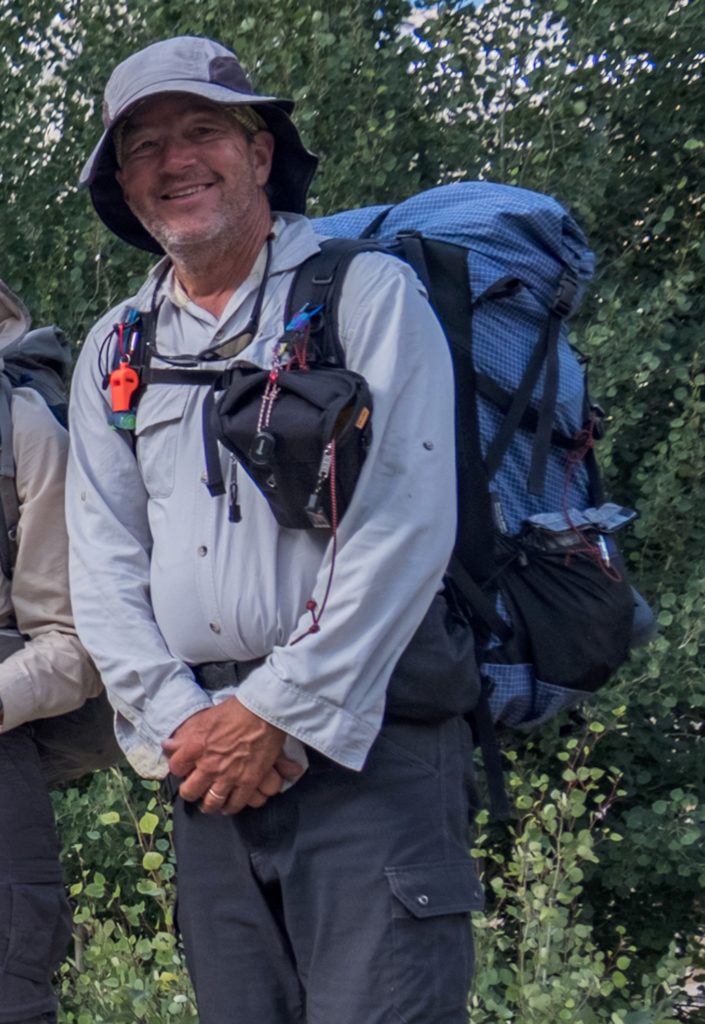
Grams | Pounds | |
Backpack/camera case/Whistle | 1,640 | 3.62 |
Waterproof cover | 84 | 0.19 |
Backpack Total | 1,724 | 3.81 |
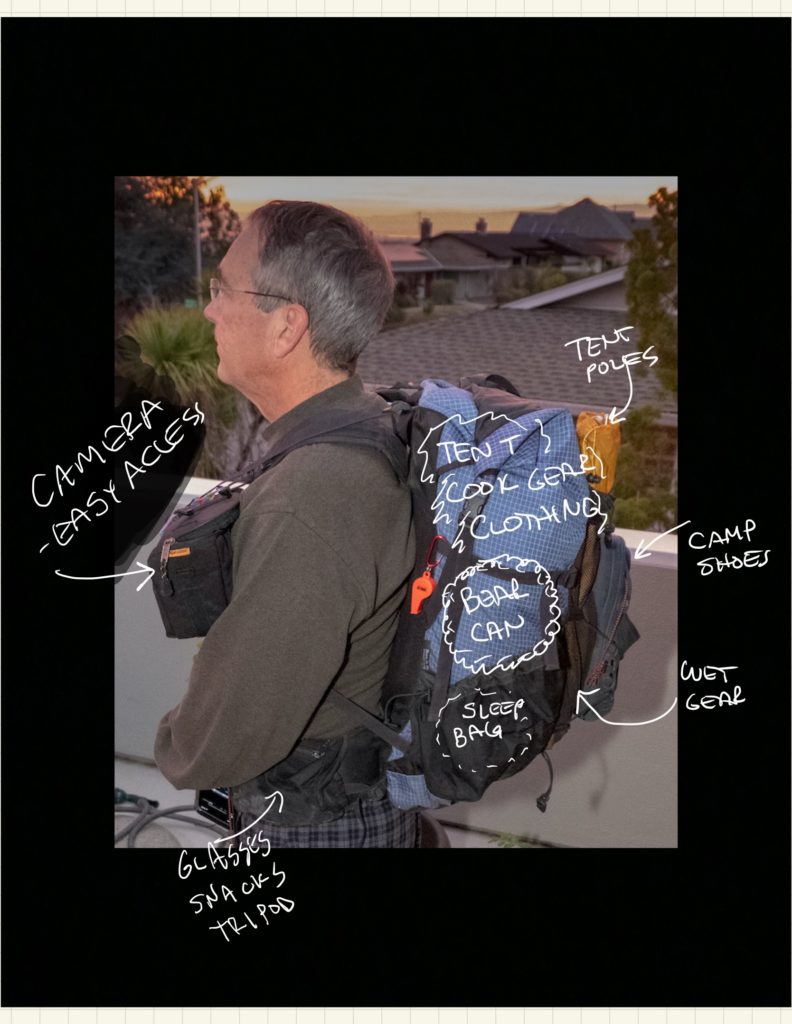
It’s taken a while to figure out how to stuff everything in the backpack so the load is even and not lopsided. I have the camera case on the front so it’s easy to grab the camera and quickly take a picture. Things you need often are easy to get to – like waterproof shell and the water filter and the sunscreen.
It’s designed to unpack and set up camp quickly. The last thing I need when setting up camp is the sleeping bag, so it’s at the bottom – stuffed in a waterproof bag. Total weight of the backpack with all the pockets and camera case is 3.8 pounds.
Tent
Lightweight / 2 person tent / all-season / waterproof
Sleep with the Backpack
Stuff it (don’t roll it)
Surprising is that a two person tent only weighs a few ounces more that a one person tent and I like to spread out. I like to have a place to chill when it’s raining or hailing. Friends can come over if we need to cook in the tent. I like storing my backpack next to me at night instead of outside covered by a waterproof cover. Just under 3 pounds and worth every ounce. As you can tell, sometimes the view from the tent is really great. I try to place the tent so I can take pictures at night from the tent.
I have a Big Agnes Fly Creek HV UL2 Tent 2 person tent that I bought in 2016 and have LOTS of days sleeping in it. I think it is now being offered as the Big Agnes Fly Creek HV2 Platinum Tent. It’s listed as 1.8 pounds, but you can see that when you add footprint, bag and entry it brings it up to 2.8 pounds. The new ones have lighter poles, but are twice the price.
https://www.rei.com/product/111798/big-agnes-fly-creek-hv-2-platinum-tent
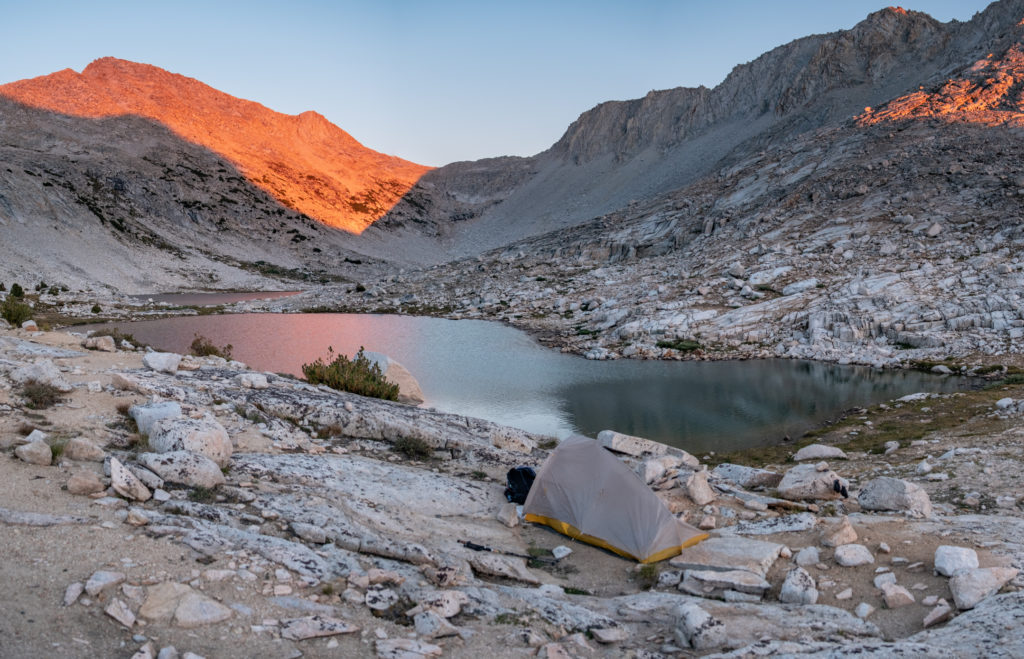
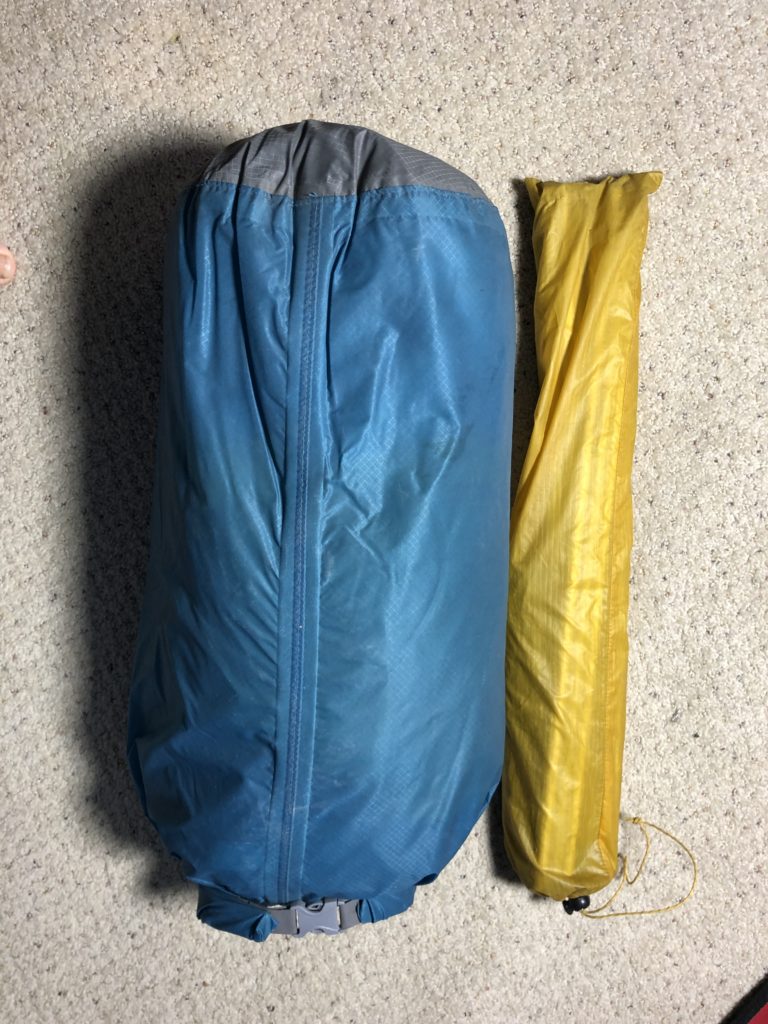
Grams | Pounds | |
Tent / Footprint/Entry | 923 | 2.04 |
Poles/Ground stakes | 336 | 0.74 |
Tent Stuff Total | 1,259 | 2.78 |
Sleeping Bag and Air Mattress
Insulated Air Mattress (LIFESAVER!!)
Air Mattress is PART of sleeping bag – can’t roll off!
Current generation is good enough to sleep on side
Down jacket stuffed to feet for
added warmth
Good to 20°F (-7°C)
Waterproof stuff sack
In case of rain /wet backpack
The biggest change in hiking from the time I was a boy scout is the comfort of an air mattress. These are 3-4 inches thick and provide warmth with a R-Value rating of about 3.3 – they have down feathers inside. It is stuffed into a sleeve in the sleeping bag so the sleeping bag has no insulation on the bottom to reduce the weight. I like a wide foot area ‘cause I do a lot of rolling when I sleep. This is good to about 20° F and weighs about 3.9 pounds for both. If I’m going to a cold place, I can bring a sleeping bag liner and thicker long-johns. I could probably save a pound here by going to a mummy sack and a 3/4 length air mattress – but I don’t think I would sleep as well. And it would be really expensive.
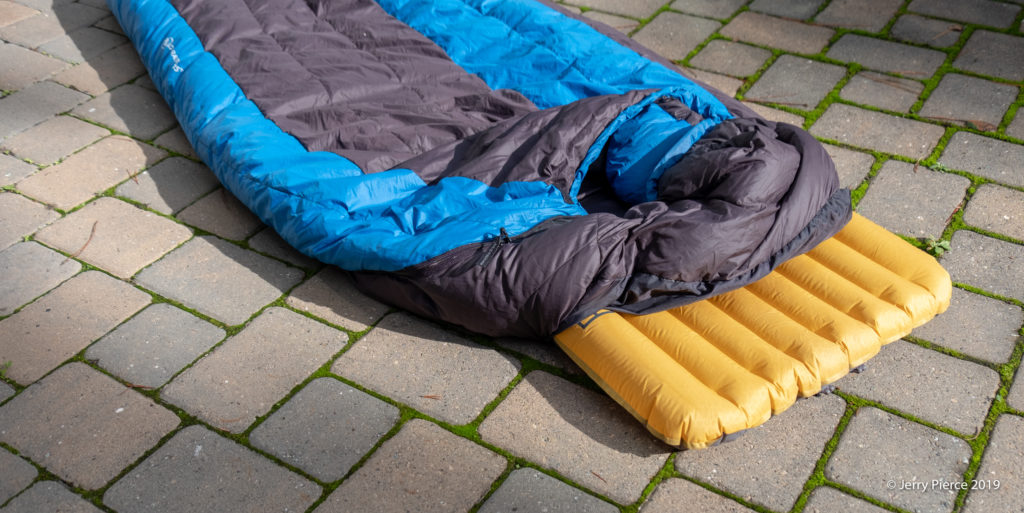
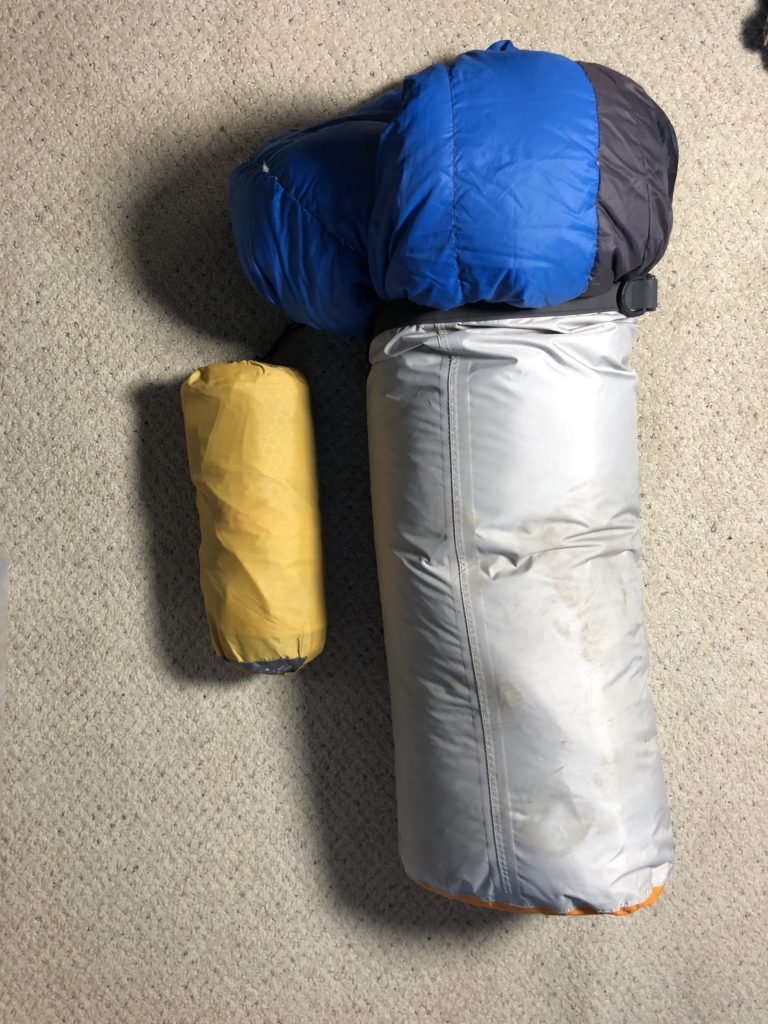
Grams | Pounds | |
Sleeping Bag and stuff sack | 1,278 | 2.82 |
Air mattress | 484 | 1.07 |
Sleeping Bag Total | 1,762 | 3.89 |
Water in the Wilderness
Water on the trail extremely important
4 miles/liter (Your mileage may vary)
Water HEAVY (2.2 pounds/liter)
Plan each day to see where water on trail – plan on filtering during hike
Water is by far the most important item that you need and it’s the heaviest. I get about 4 miles to the liter when hiking and I use another liter at lunch and 1-2 liters in the evening. We use filters to clean up the water these days – gone are the chemicals and UV light sources that have been popular over the years. Things have changed! I have moved to smart water bottles only with an adapter for a tube. I’ve moved to a Katadyn BeFree water filter – but WARNING the supplied bag is very fragile and I bring a backup bag (also to hold water). We look at the day’s hiking to see where we can get water on the trail and only bring enough water to make it to the crossing and get more water.
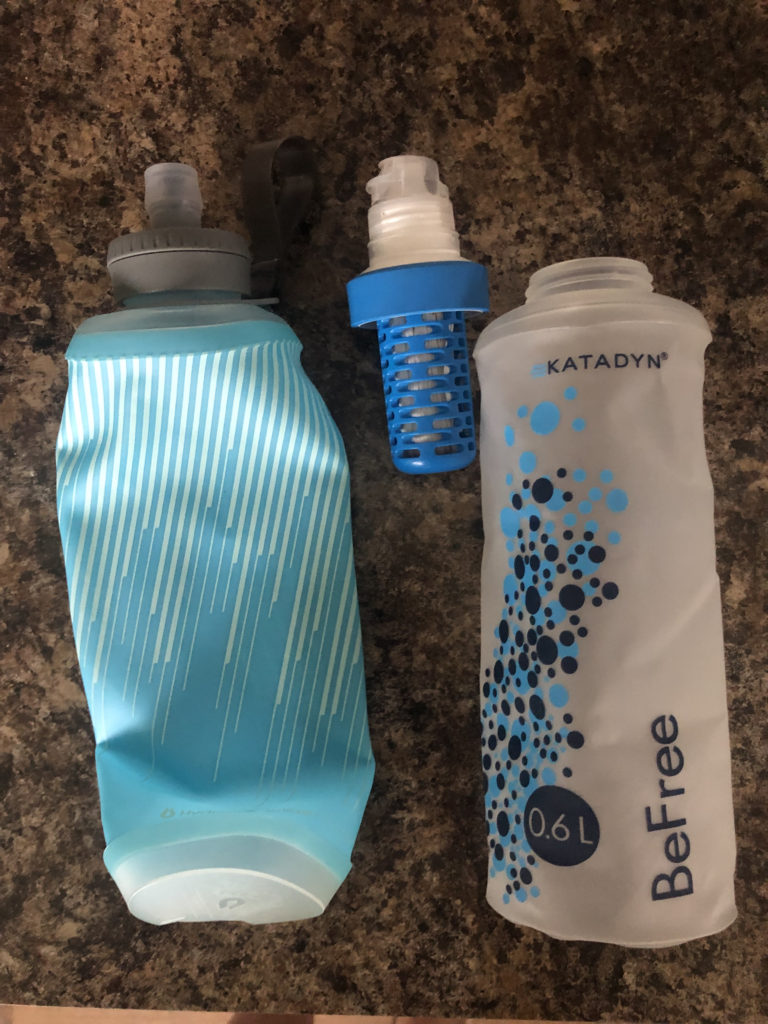
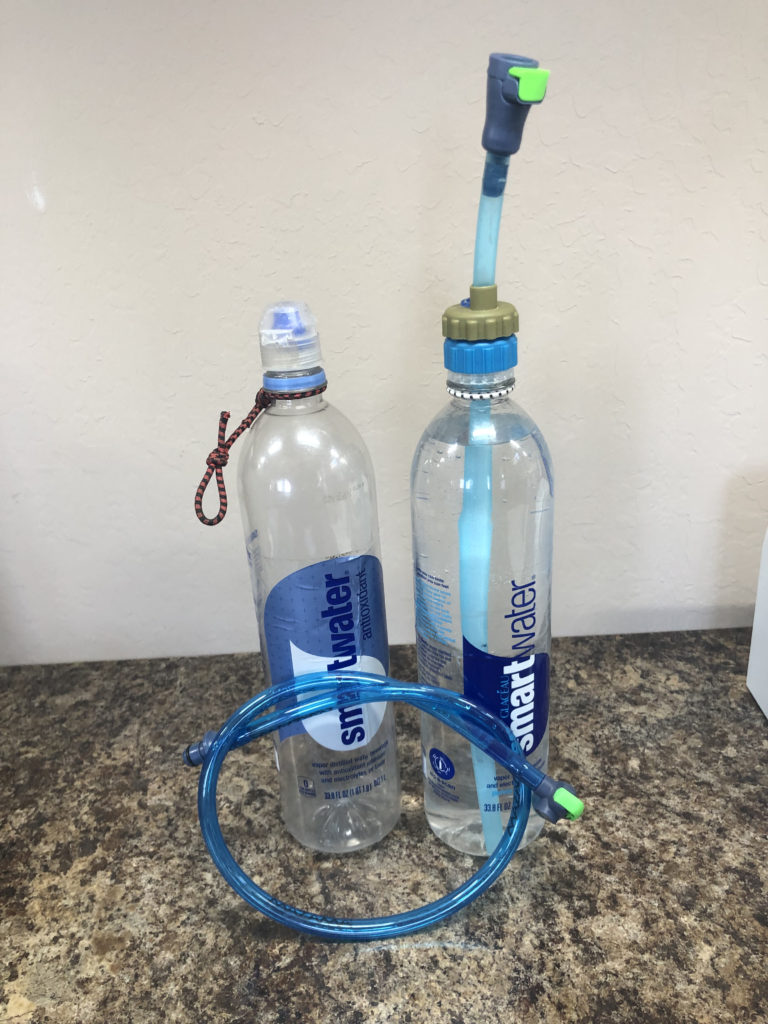
Water Gear | Grams | Pounds | Ounces |
Smart Bottle plus tube | 123 | 0.27 | 4 |
Smart Water Bottle | 44 | 0.10 | 2 |
Katakyn .6l bottle (spare and more water) | 77 | 0.17 | 3 |
Katakyn Water Filter | 58 | 0.13 | 2 |
Total Water Gear: | 302 | 0.67 | 11 |
Taking Care of Business
Dig Cat-hole
6” deep IN ROCKS or ROOTS
Squat (aim) and try not to splash
No paper left behind
Used paper in plastic bag
How much TP do you need for 8 days?
Minimum 4 squares per “sitting”
Plan on 2 sittings a day (assuming not sick) and bring 2x. 128 TP squares.
Yes, there really is a book called “How to Shit in the Woods.” Not a bad book really, but doesn’t cover some of the more critical issues like how to avoid splashing. Or, perhaps more importantly, how to handle mosquitos when that soft, unprotected skin is a potential target. You really don’t want a mosquito bite there. Digging a hole seems like an easy thing to do, but in rocky terrain or where there are lots of roots it can be a challenge. Especially when you are in a hurry. Some of my friends dig their cat-hole the prior night so when in a rush, it’s a quicker trip.

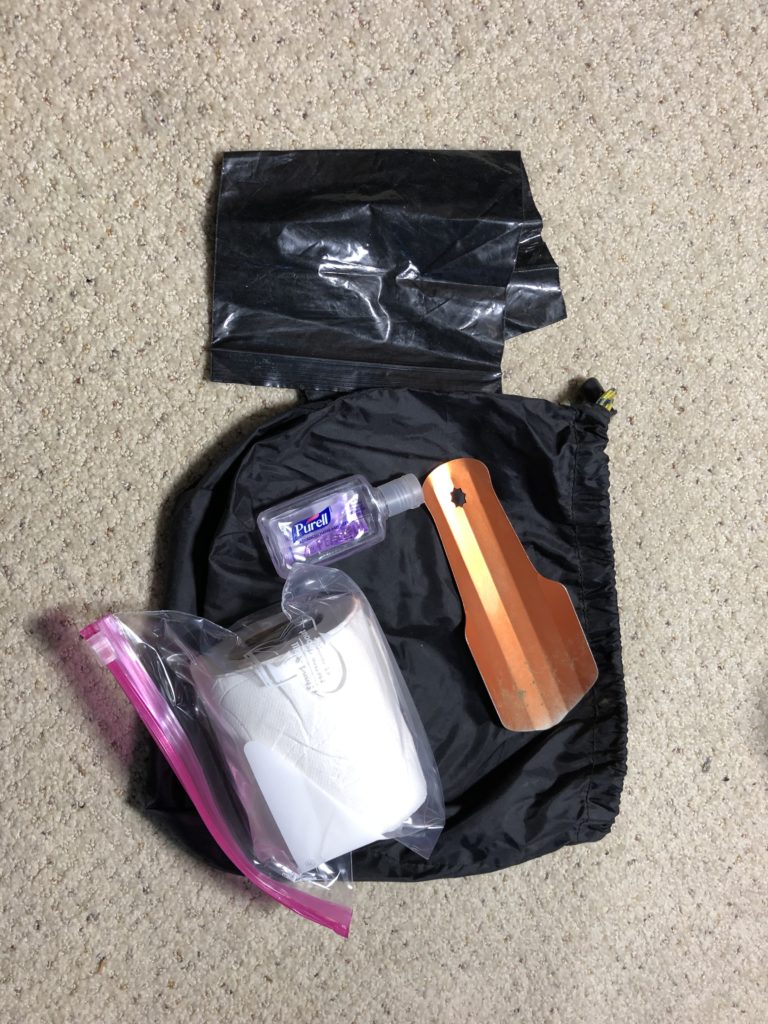
Toiletries | Gram | Pounds |
Toilet Paper, Spade, Black Bag, Hand Sanitizer | 111 | 0.25 |
Personal Stuff
Eating: Bowl, Insulated mug, Spoon, Soap, Sponge, bag
Hygene: Toothbrush, Floss, Toothpaste, comb, Advil/daily vitamins, Chapstick, Insect Repellent, Suntan lotion, bag
Stuff: Towel, extra reading glasses, lighter, tiny knife, maps and compass
All of these get use on almost every trip
Then there are the usual eating containers the all important morning coffee, soups, main course and oatmeal! I always bring my tooth brush, floss, vitamins, chapstick, sunscreen and insect repellent – basic stuff and bags to hold them. I also bring diaper pins, cause you might need ‘em when something breaks.
I bring a batch of odds-and-ends that are all important. I bring a bug hat – and have used it in times for mosquitos. Have I mentioned how much I don’t like mosquitos? I bring a clothes line to dry socks and undies and other things that are washed. I even bring a sitting pad for in-camp comfort (and kneeling comfort while cooking).
We also bring paper maps and a compass for back-up navigation.
Just so you know, Advil is a considered recreational drug!
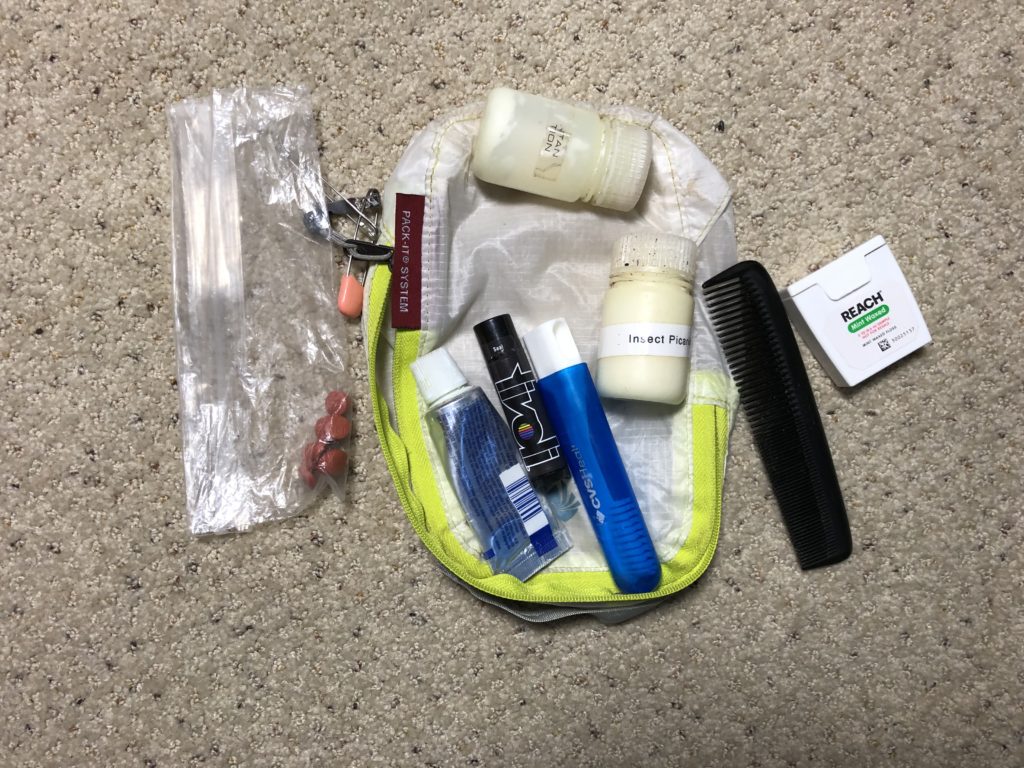
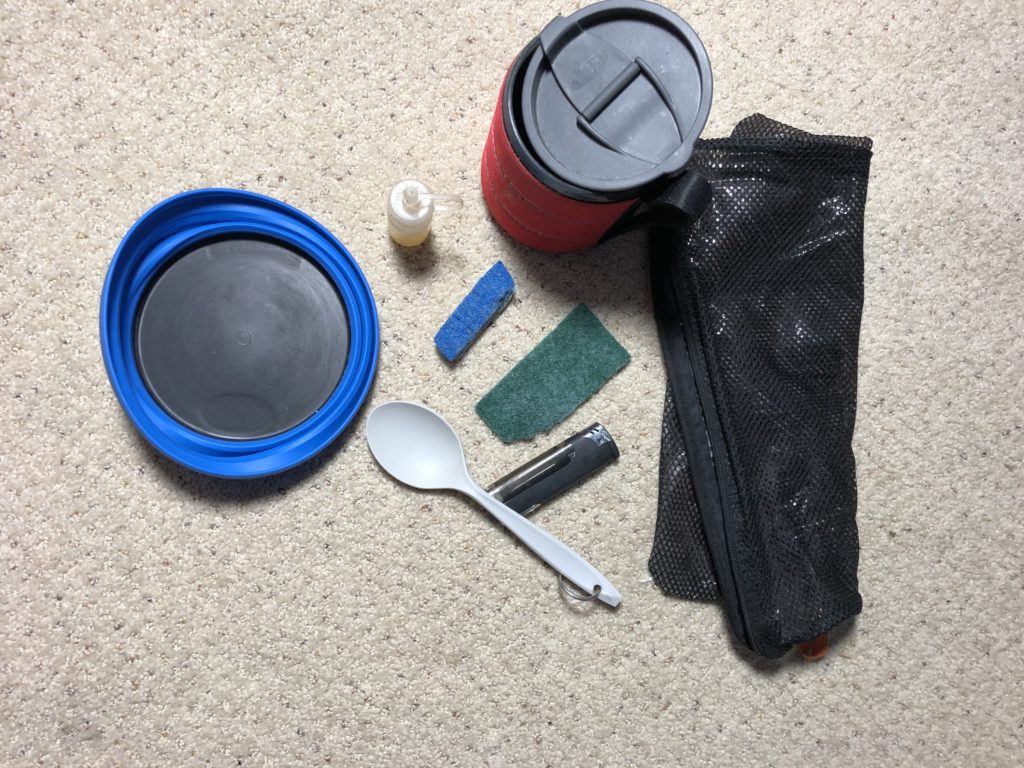
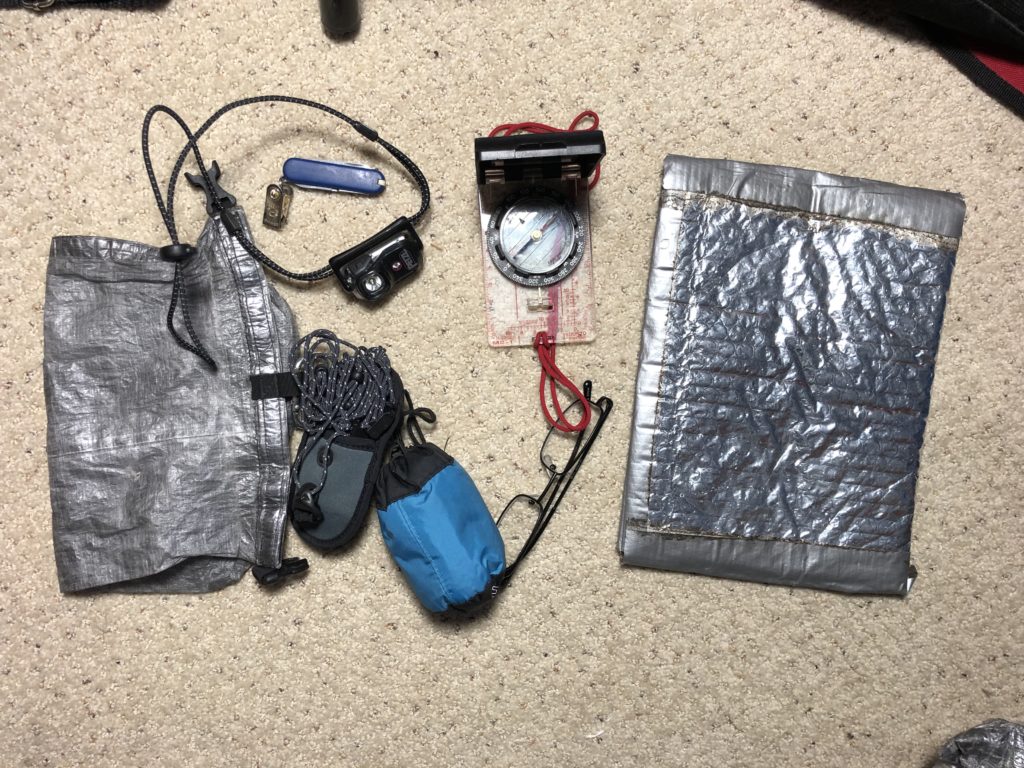
Grams | Pounds | |
Lighter | 18 | 0.04 |
Knife/Leatherman | 22 | 0.05 |
Reading Glasses | 20 | 0.04 |
Sitting pad | 31 | 0.07 |
Clothes Line | 26 | 0.06 |
Bug Hat | 23 | 0.05 |
Compass | 72 | 0.16 |
Maps | 18 | 0.04 |
$$ / Driver’s license | 14 | 0.03 |
Pens/Paper/Lens cleaner | 31 | 0.07 |
Towel | 45 | 0.10 |
Dark Glasses (and case) | 86 | 0.19 |
Toothpaste, bag, toothbrush, insect repellant, meds, advil, | 180 | 0.40 |
Cup/Spoon/Plate/cleaning stuff | 283 | 0.62 |
Total | 869 | 1.92 |

And then you get to see sights like this after dinner. One of my favorite campsites in the sierra – Grouse Lake. About 8 miles up 4,000 ft climb in Kings Canyon – off trail. This photo has been photoshopped to allow both the people and the background to be in focus. Two pictures combined together – the eye saw it right, the camera needed some help…
Electronic Stuff
Rechargeable Flashlight
Satellite modem
The “brick” is the elephant in the bag … almost 1 pound!!
Why not solar power????
Electronics include a rechargeable headlamp and a satellite modem – more on that in a bit – but look at the Battery Brick – almost a full pound! Really? Why not solar?
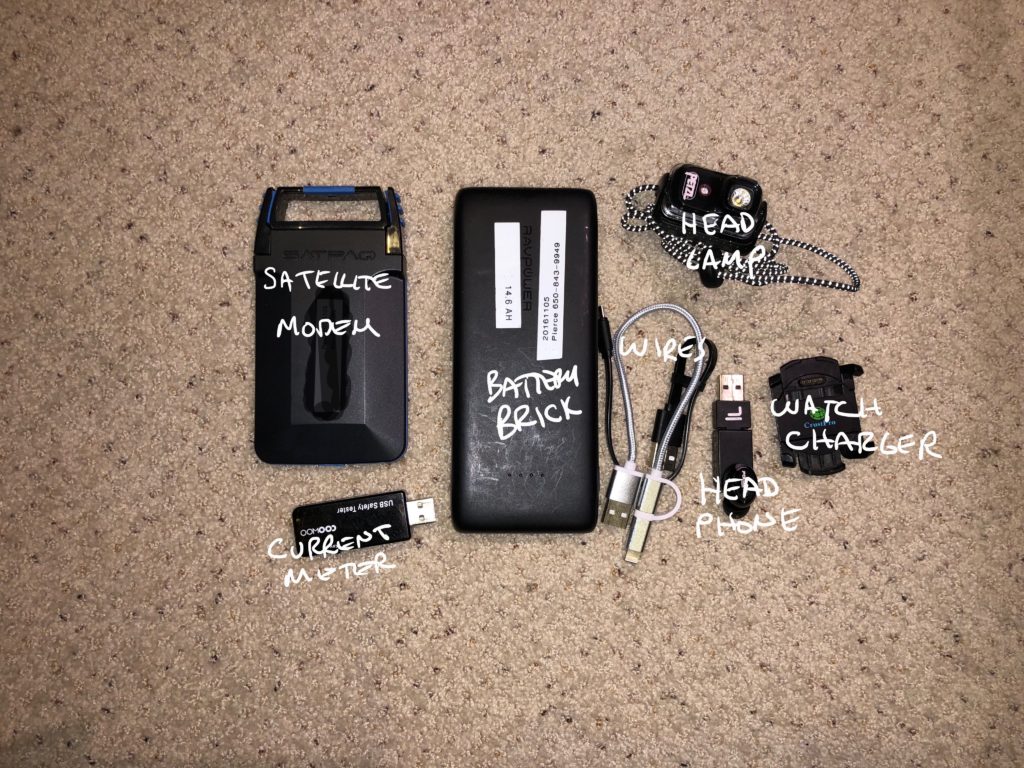
Electronics | Grams | pounds |
Flashlight (usb rechargable) | 35 | 0.08 |
Headphone (USB rechargeable) | 11 | 0.02 |
Satellite receiver/transmitter | 125 | 0.28 |
Wires | 58 | 0.13 |
Battery Brick | 413 | 0.91 |
Total | 642 | 1.42 |
Solar vs Brick
Power Use:
iPhone 20% per day or {20% times 2,800mAH} = 560mAH / day
Garmin Fenix 3 – 50% per day or {50% times 380mAH} = 200mAH / day
Fujifilm X-T2 15% per day or {15% times 2,000mAH} = 300mAH / day
HeadLight 10% per day
Earphone 10% per day
Total of 1.4 AH/day to meet my needs
7 days = 10AH
Bottom Line: Brick slightly heavier and much more convenient.
It took me a long time to figure out how much power I needed and what it took to meet those needs. Bottom line I use about 1.4AH/day – most of which goes to my all-important navigation tool the iPhone. So for a 7 day hike I need a total of about 10AH. A brick holds 14AH so that does it all. Solar takes too much time in direct sunlight to do any good. (If you see someone hiking with a solar panel on their back, it’s just for show. You really don’t generate that much power when in and out of shade.) So given same weight and more convenient it’s brick for me.
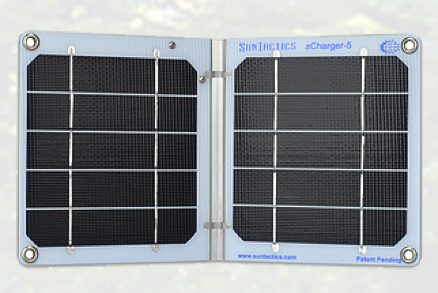
Solar takes about 2 hours direct sunlight to achieve about 1.2AH
Weight (including small battery): 0.88 pounds
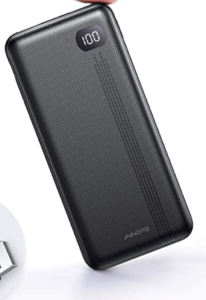
Brick holds about 14AH
Weight: 0.91 pounds
Communication
NEED to send “all OK” message once a day
Spousal unit requires it
Emergency communication
Satellite only way
InReach (low orbit sat) vs SatPaq (geosynchronous sat)
Same weight (0.25 pounds)
SatPaq instant feedback / faster send
SatPaq cheaper / no monthly
I have been using satellite communication for a number of years now and it’s really a great safety accessory. My wife now demands that I use it – both so she knows I’m OK and that I can get help if needed (I’ve never needed it). This is my new favorite toy and it’s called a SatPaq. I have been a beta tester for SatPaq for about a year, they just came to market.
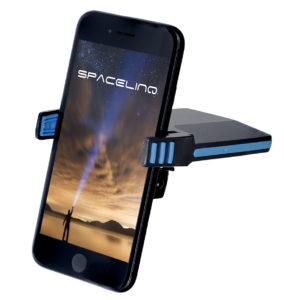
Let me show you it in action. (click to play) You use it like a text messaging program. Physically attach the satellite modem to the phone – electrically it connects via bluetooth – it uses the phones GPS, compass and tilt sensors to know where to point – type in the message and aim it at the satellite. It sends immediately and you have positive confirmation that it works. It doesn’t work everywhere – like in a deep canyon – you need line of sight to the satellite, but the augmented reality program lets you see if the satellite is in sight. I really like it! I want them to be successful, please go out and buy one in case of earthquake or a drive to Las Vegas.
SatPaq.com
Only pay for messages (under 40¢/message), no monthly
Good for hiking and emergency communications —
Earthquake or Remote Areas
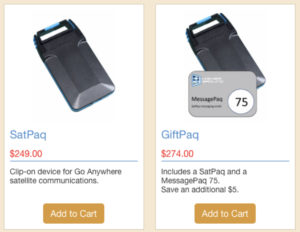
Camera and Accessories
Canon EOS R5 Mirrorless with 24-240 lens
NO SPARE BATTERY (my brick can do the charging)
Polarized filter
Mini-tripod
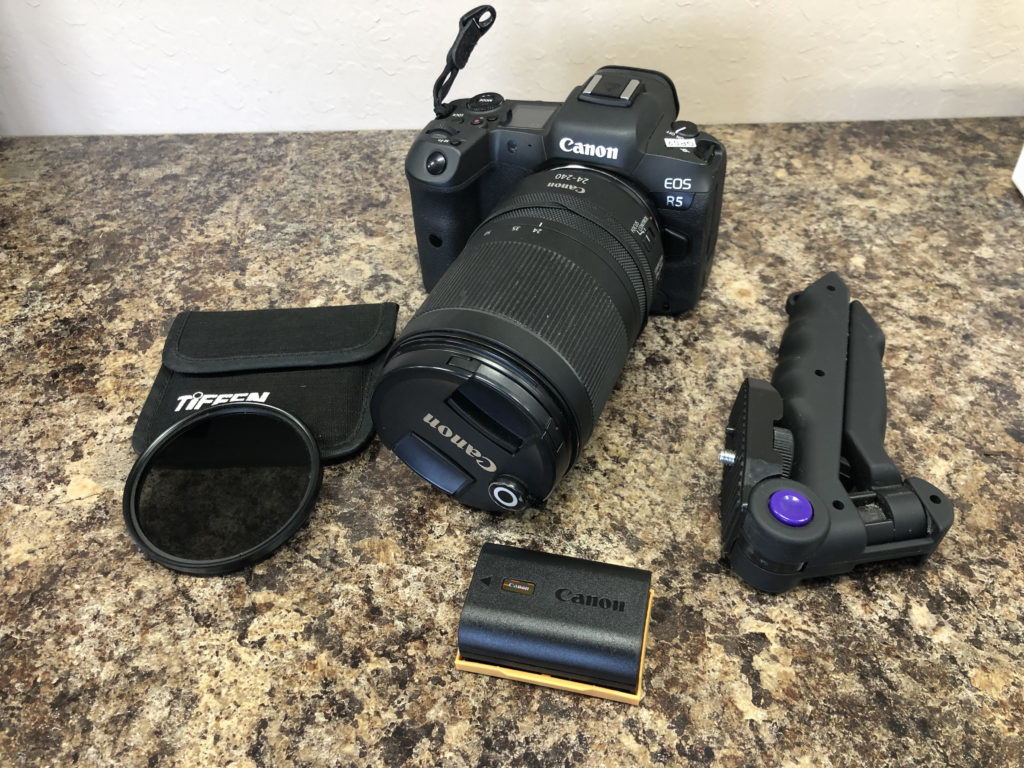
And the items that weighs too much – coming in at 3.7 pounds – more the same as my tent – is another brick – the camera. Well, actually the LENS is the brick, since that is the heavy part. I could hike with a single 18mm lens, but I like the optical zoom. It’s just a damn good camera. We will return to the camera later… But it’s heavy compared to the OTHER camera I bring – an iPhone ten. We will look at the differences between the two in a little bit.
I recently updated from a Fuji camera that was over a pound lighter, but the Canon does such a better job of taking pictures.
Canon Camera | Grams | Pounds | Ounces |
Camera with Lens | 1,506 | 3.32 | 53 |
Battery | 0 | 0.00 | 0 |
Filter | 53 | 0.12 | 2 |
Tripod | 104 | 0.23 | 4 |
Total | 1,663 | 3.67 | 59 |

But the resultant images make it all worthwhile. This was taken in Sequoia National Park at sunset two years ago. We had just had an encounter with a ranger who threatened to give us a ticket ‘cause she didn’t like how we were tying up our food at night. A very unpleasant person, but what a great place to camp! What was she complaining about?
BEARS!!
Rules for most remote areas require the use of a Bear Canister
VERY heavy, hard to pack, GOOD CHAIR!
Bears can’t open these.
I have seen bears in the wild
Swimming nearby, eating berries, walking around
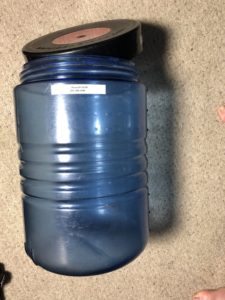
We had not carried bear canisters, we were tying up food at night in an alternative means of protection, an Ursack. It was to hand food at that park, she just didn’t like it.
Most places require outrageously heavy bear canisters. These 2.6 pound monsters are designed to be bear proof so all your smelly things, from toothpaste to dinners go in the canister and the canisters are placed on the ground away from the campground at night. They make for good in-camp chairs – well there’s one benefit. This has been going on for many years and bears no longer see humans as sources of food, so they avoid us as much as we try to avoid them. It’s heavy and there are better options, that Ursack I mentioned, but they are not approved by the park department (yet).
Gram | Pounds | |
Bear Canister | 1,155 | 2.55 |
Cooking (Common Gear – split with 3-4 people)
Group Water filter – Gravity / 12 liters
Isobutane stove and canisters
0.5 oz / person / day
0.5 *3 *8 = 12 oz
Pots / cozy / lids /
common cooking gear
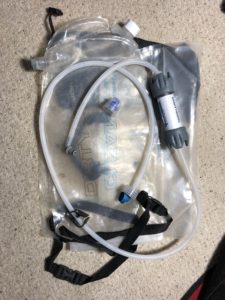
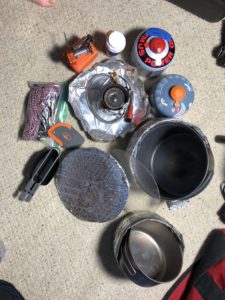
Common gear is food, cooking, medical and water supplies. We normally bring two pots, a primary stove, a tiny back up stove and cooking utensils. We also bring the group filtering stuff which in a pinch can carry 12 liters of water from a remote location to a dry camp. The split with 4 people means about 1.5 pounds per person for the common hardware.
Common Gear | Gram | Pounds |
Group Water Filter and bags | 431 | 0.95 |
Stove | 295 | 0.65 |
Extra dirty water bag | 106 | 0.23 |
Spare Stove | 110 | 0.24 |
Medical Kit | 250 | 0.55 |
2 pots and cozy | 352 | 0.78 |
Tops | 80 | 0.18 |
Etc. cooking stuff | 163 | 0.36 |
Isobutane (8 days/4 people) 16oz two cans | 784 | 1.73 |
Total | 2,571 | 5.68 |
Split 3 people / per person | 857 | 1.89 |
Food
Dinners: Soup and Entree (dehydrated)
Breakfast: Muesli or Oatmeal w/ powdered whole milk (and Coffee)
Lunch: Mixed nuts, jelly beans, jerky (and water flavoring)
Dinner snacks: Chocolate
Food is next and I’ve been really lucky to have my friend Pat create spectacular meals for the trail at an incredibly low 1 pound per person per day. I make up my own breakfast and lunch and she home-dehydrates main meals. We use store-bought soup that we make a little over 1.5 cups per person of soup – we need the liquid. And really good main dishes from Mushroom Stroganoff with Rice to Pulled Pork with Grits.
We are not hungry on the trail! We do lose weight – I normally lose about 5 to 7 pounds on the first hike of the season, but we just don’t get hungry. Find a friend like Pat if you go hiking – or learn to make good food – there are lots of books of menus for backpacking!!
Food is the heaviest thing we carry at the start of a hike, however we lose a pound a day in our backpack as the hike goes on. 8 day hike, 8 pounds at the start! 20% of my pack weight!
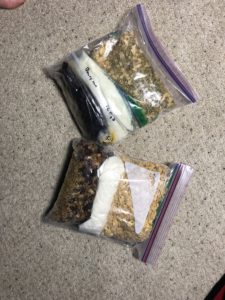
Gram | Pounds | |
Breakfast | 100 | 0.22 |
Lunch | 145 | 0.32 |
Snacks/chocolate, coffee, lemonade, creamer | 35 | 0.08 |
Main Meal / person | 160 | 0.35 |
Per person/per day | 440 | 0.97 |
8 day per person total | 3520 | 7.77 |
Day | Soup | Entree |
1 | Sweet corn chowder | Mushroom burgundy with potato |
2 | Tortilla | Pulled pork with grits |
3 | Split pea | Arrabiata Marinara with veggies with quinoa |
4 | Curry Lentil/Corn Chowder | Stacked Enchiladas |
5 | Curry Lentil | Mushroom stroganoff with rice |
6 | Sweet corn chowder | Minestrone soup with potato |
7 | Curry Lentil/Split Pea | Pulled pork with grits |
8 | Split pea/Corn Chowder | Veg Chili |
Total Weight
Gram | Pounds | |
Clothing in Backpack | 2,020 | 4.46 |
Personal Water Supplies | 303 | 0.67 |
Tent | 1,259 | 2.78 |
Backpack | 1,724 | 3.81 |
Sleeping Bag | 1,762 | 3.89 |
Non-Electronic Hardware | 869 | 1.92 |
TP Care | 111 | 0.25 |
Electronics | 642 | 1.42 |
Camera | 1,171 | 2.58 |
Bear Cannister | 1,155 | 2.55 |
Subtotal Fixed: | 11016 | 24.32 |
Group Gear | 857 | 1.89 |
Food (8 days) | 3520 | 7.77 |
Water (2 liters) | 2000 | 4.42 |
On Back at start: | 17393 | 38.40 |
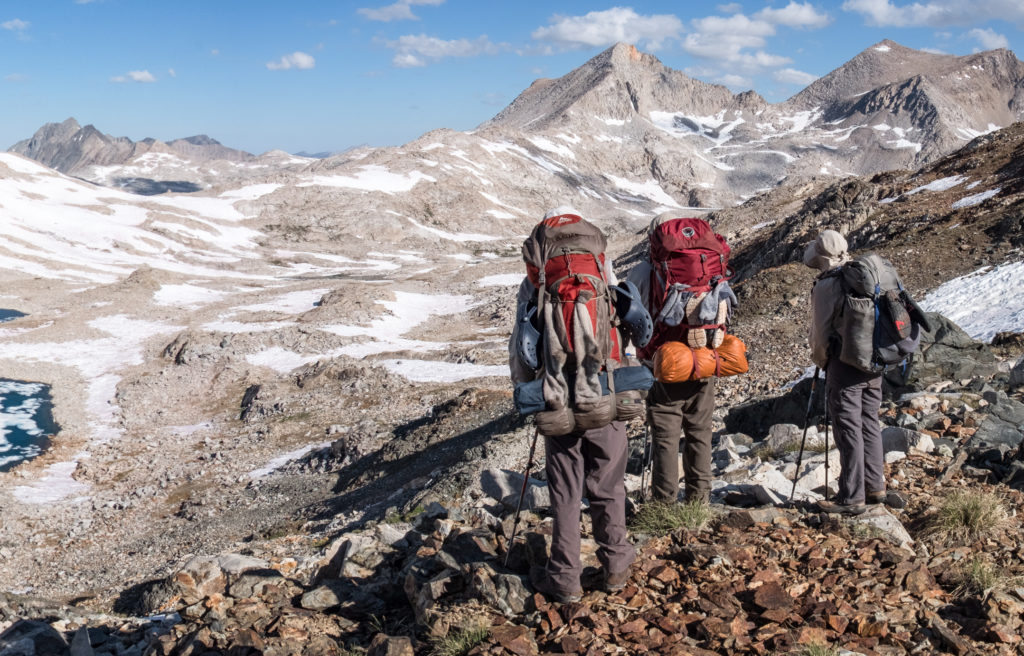
Then bringing it all together again – this give the breakdown of the 37.5 pounds of dead weight, not including my clothing and fat. The water and food are a hefty part of the weight and can vary depending on trail conditions, water availability AND how many days we have been on the trail. To say the least it’s a heavy load. Because of the camera and electronics I carry more than others. The stylish backpacks in the picture are experienced hikers and they started between 30 and my 38 pounds at the start of this hike.